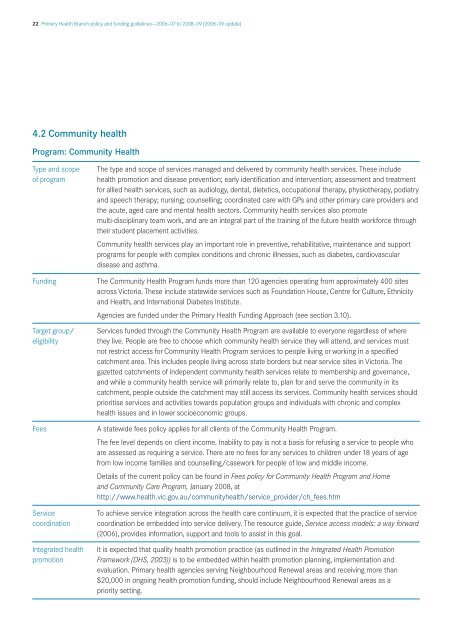Primary Health Branch policy and funding guidelines
Primary Health Branch policy and funding guidelines
Primary Health Branch policy and funding guidelines
Create successful ePaper yourself
Turn your PDF publications into a flip-book with our unique Google optimized e-Paper software.
22 <strong>Primary</strong> <strong>Health</strong> <strong>Branch</strong> <strong>policy</strong> <strong>and</strong> <strong>funding</strong> <strong>guidelines</strong>––2006–07 to 2008–09 (2008–09 update)<br />
4.2 Community health<br />
Program: Community <strong>Health</strong><br />
Type <strong>and</strong> scope<br />
of program<br />
Funding<br />
Target group/<br />
eligibility<br />
Fees<br />
Service<br />
coordination<br />
Integrated health<br />
promotion<br />
The type <strong>and</strong> scope of services managed <strong>and</strong> delivered by community health services. These include<br />
health promotion <strong>and</strong> disease prevention; early identification <strong>and</strong> intervention; assessment <strong>and</strong> treatment<br />
for allied health services, such as audiology, dental, dietetics, occupational therapy, physiotherapy, podiatry<br />
<strong>and</strong> speech therapy; nursing; counselling; coordinated care with GPs <strong>and</strong> other primary care providers <strong>and</strong><br />
the acute, aged care <strong>and</strong> mental health sectors. Community health services also promote<br />
multi-disciplinary team work, <strong>and</strong> are an integral part of the training of the future health workforce through<br />
their student placement activities.<br />
Community health services play an important role in preventive, rehabilitative, maintenance <strong>and</strong> support<br />
programs for people with complex conditions <strong>and</strong> chronic illnesses, such as diabetes, cardiovascular<br />
disease <strong>and</strong> asthma.<br />
The Community <strong>Health</strong> Program funds more than 120 agencies operating from approximately 400 sites<br />
across Victoria. These include statewide services such as Foundation House, Centre for Culture, Ethnicity<br />
<strong>and</strong> <strong>Health</strong>, <strong>and</strong> International Diabetes Institute.<br />
Agencies are funded under the <strong>Primary</strong> <strong>Health</strong> Funding Approach (see section 3.10).<br />
Services funded through the Community <strong>Health</strong> Program are available to everyone regardless of where<br />
they live. People are free to choose which community health service they will attend, <strong>and</strong> services must<br />
not restrict access for Community <strong>Health</strong> Program services to people living or working in a specified<br />
catchment area. This includes people living across state borders but near service sites in Victoria. The<br />
gazetted catchments of independent community health services relate to membership <strong>and</strong> governance,<br />
<strong>and</strong> while a community health service will primarily relate to, plan for <strong>and</strong> serve the community in its<br />
catchment, people outside the catchment may still access its services. Community health services should<br />
prioritise services <strong>and</strong> activities towards population groups <strong>and</strong> individuals with chronic <strong>and</strong> complex<br />
health issues <strong>and</strong> in lower socioeconomic groups.<br />
A statewide fees <strong>policy</strong> applies for all clients of the Community <strong>Health</strong> Program.<br />
The fee level depends on client income. Inability to pay is not a basis for refusing a service to people who<br />
are assessed as requiring a service. There are no fees for any services to children under 18 years of age<br />
from low income families <strong>and</strong> counselling/casework for people of low <strong>and</strong> middle income.<br />
Details of the current <strong>policy</strong> can be found in Fees <strong>policy</strong> for Community <strong>Health</strong> Program <strong>and</strong> Home<br />
<strong>and</strong> Community Care Program, January 2008, at<br />
http://www.health.vic.gov.au/communityhealth/service_provider/ch_fees.htm<br />
To achieve service integration across the health care continuum, it is expected that the practice of service<br />
coordination be embedded into service delivery. The resource guide, Service access models: a way forward<br />
(2006), provides information, support <strong>and</strong> tools to assist in this goal.<br />
It is expected that quality health promotion practice (as outlined in the Integrated <strong>Health</strong> Promotion<br />
Framework (DHS, 2003)) is to be embedded within health promotion planning, implementation <strong>and</strong><br />
evaluation. <strong>Primary</strong> health agencies serving Neighbourhood Renewal areas <strong>and</strong> receiving more than<br />
$20,000 in ongoing health promotion <strong>funding</strong>, should include Neighbourhood Renewal areas as a<br />
priority setting.

















